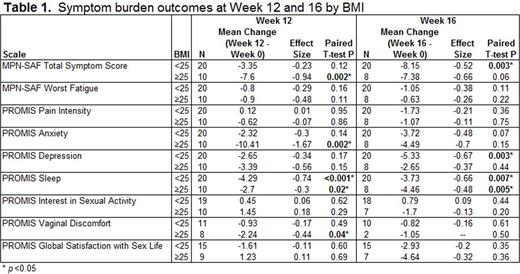Abstract
Introduction: Polycythemia vera (PV), essential thrombocythemia (ET), and myelofibrosis (MF) are chronic, Philadelphia-negative myeloproliferative neoplasms (MPNs) that are characterized by deregulated myeloid lineage cell production, leading to a high symptom burden, including abdominal pain/discomfort from splenomegaly, fatigue, depressive symptoms, sleep disturbance, sexual problems, and pruritis, among other symptoms. Yoga interventions have been demonstrated to be efficacious for improving symptom burden in other cancer populations. Additionally weight has been shown to moderate symptom burden response in cancer patients. In MPN patients, it is unknown if weight influences symptom burden response. Therefore, the purpose of this analysis was to examine the differences at baseline and post-intervention in symptom burden between overweight and normal weight MPN patients participating in an online yoga intervention.
Methods: MPN patients were asked to participate in 60 minutes of online-streamed yoga weekly for 12 weeks. Participants were asked to complete online self-report surveys administered via Qualtrics at baseline (week 0), mid-point (week 7), post-intervention (week 12), and follow-up (week 16). Survey measures included demographics, total symptom burden and fatigue (MPN Symptom Assessment Form [MPN SAF]) as well as NIH PROMIS measures of pain, anxiety, depression, sleep, and sexual function. BMI status was determined through self-report height and weight obtained in the baseline survey. For statistical analyses, BMI was dichotomized into an overweight (OW) category (BMI ≥25 kg/m2) and a normal weight (NW) category (BMI <25 kg/m2).
Results: A total of 38 MPN patients completed the 12-week intervention. The majority of participants were diagnosed with either PV (n=16) or ET (n=16), with MF being less common (n=6). Median age was 56 years (range 29-72) with most participants being female (n=34). A minority were OW (n=12). At baseline, total symptom score (TSS) was descriptively higher in OW vs NW participants (mean 42.8 [SD 16.2] vs 32.7 [SD 10.9], p=0.06) with no other differences observed for PROMIS outcomes. OW participants had significantly improved TSS (p=0.002), anxiety (p=0.002), sleep (p=0.02), and vaginal discomfort (p=0.04) at the end of the intervention (week 12, Table 1). Improvements in NW participants did not reach statistical significance for any scales except sleep at week 12 (p<0.001). From baseline to follow-up (week 16), NW participants had significant improvements in TSS (p=0.003), depression (p=0.003), and sleep (p=0.007). OW participants maintained significant improvements in only sleep at week 16 (p=0.005).
Conclusion: In MPN patients participating in a 12-week, online streamed yoga intervention, some differences in response to the intervention were observed between OW and NW participants. However, statistical power for definitive analysis of weight as a moderator for improvement in symptom burden was limited due to a small sample size. Considering the lack of interventions in MPN patients and the potential role that weight has on outcomes in other cancer populations, a randomized controlled trial investigating the effects of online yoga in a larger sample of MPN patients is warranted along with further investigation of effectiveness of the intervention within groups of participants by weight.
Gowin:Incyte: Membership on an entity's Board of Directors or advisory committees. Mesa:Promedior: Research Funding; Incyte: Research Funding; Ariad: Consultancy; CTI Biopharma: Research Funding; Novartis: Consultancy; Gilead: Research Funding; Galena: Consultancy; Celgene: Research Funding.
Author notes
Asterisk with author names denotes non-ASH members.


This feature is available to Subscribers Only
Sign In or Create an Account Close Modal